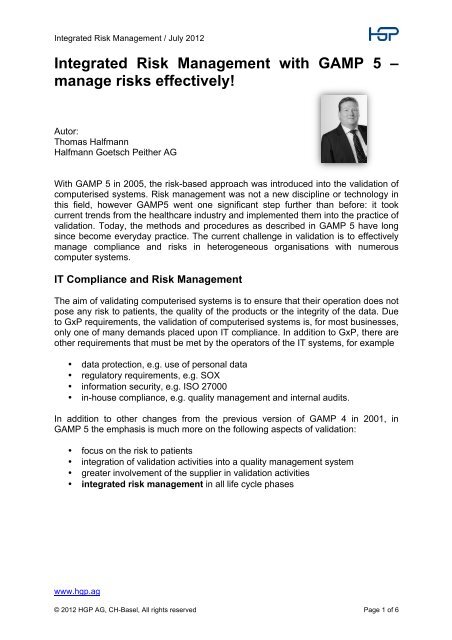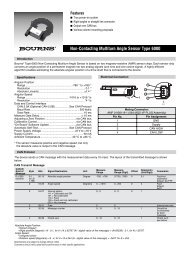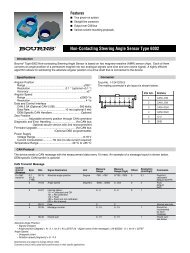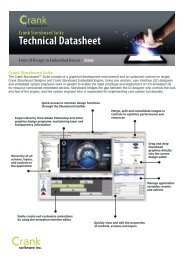Integrated Risk Management with GAMP 5 â manage ... - we.CONECT
Integrated Risk Management with GAMP 5 â manage ... - we.CONECT
Integrated Risk Management with GAMP 5 â manage ... - we.CONECT
You also want an ePaper? Increase the reach of your titles
YUMPU automatically turns print PDFs into web optimized ePapers that Google loves.
<strong>Integrated</strong> <strong>Risk</strong> <strong>Management</strong> / July 2012<br />
<strong>Integrated</strong> <strong>Risk</strong> <strong>Management</strong> <strong>with</strong> <strong>GAMP</strong> 5 –<br />
<strong>manage</strong> risks effectively!<br />
Autor:<br />
Thomas Halfmann<br />
Halfmann Goetsch Peither AG<br />
With <strong>GAMP</strong> 5 in 2005, the risk-based approach was introduced into the validation of<br />
computerised systems. <strong>Risk</strong> <strong>manage</strong>ment was not a new discipline or technology in<br />
this field, ho<strong>we</strong>ver <strong>GAMP</strong>5 <strong>we</strong>nt one significant step further than before: it took<br />
current trends from the healthcare industry and implemented them into the practice of<br />
validation. Today, the methods and procedures as described in <strong>GAMP</strong> 5 have long<br />
since become everyday practice. The current challenge in validation is to effectively<br />
<strong>manage</strong> compliance and risks in heterogeneous organisations <strong>with</strong> numerous<br />
computer systems.<br />
IT Compliance and <strong>Risk</strong> <strong>Management</strong><br />
The aim of validating computerised systems is to ensure that their operation does not<br />
pose any risk to patients, the quality of the products or the integrity of the data. Due<br />
to GxP requirements, the validation of computerised systems is, for most businesses,<br />
only one of many demands placed upon IT compliance. In addition to GxP, there are<br />
other requirements that must be met by the operators of the IT systems, for example<br />
• data protection, e.g. use of personal data<br />
• regulatory requirements, e.g. SOX<br />
• information security, e.g. ISO 27000<br />
• in-house compliance, e.g. quality <strong>manage</strong>ment and internal audits.<br />
In addition to other changes from the previous version of <strong>GAMP</strong> 4 in 2001, in<br />
<strong>GAMP</strong> 5 the emphasis is much more on the following aspects of validation:<br />
• focus on the risk to patients<br />
• integration of validation activities into a quality <strong>manage</strong>ment system<br />
• greater involvement of the supplier in validation activities<br />
• integrated risk <strong>manage</strong>ment in all life cycle phases<br />
www.hgp.ag<br />
© 2012 HGP AG, CH-Basel, All rights reserved Page 1 of 6
<strong>Integrated</strong> <strong>Risk</strong> <strong>Management</strong> / July 2012<br />
<strong>Risk</strong> <strong>manage</strong>ment, as also required in <strong>GAMP</strong> 5, helps to meet compliance<br />
requirements in a focussed and efficient way. <strong>GAMP</strong> 5 suggests a five-step risk<br />
<strong>manage</strong>ment process (<strong>GAMP</strong> 5, Appendix M3, Science Based Quality <strong>Risk</strong><br />
<strong>Management</strong>), whereby this article focusses mainly on the last two steps of the<br />
process:<br />
Figure 1: <strong>GAMP</strong> 5 risk <strong>manage</strong>ment process<br />
Based on the compliance frameworks (e.g. GxP, SOX etc.) and an appropriate risk<br />
analysis, controls are specified that ensure the regular review and monitoring of<br />
identified risks. In the classic approach, these controls are introduced and monitored<br />
separately for all compliance frameworks.<br />
Figure 2: <strong>Risk</strong> <strong>manage</strong>ment for different compliance requirements<br />
www.hgp.ag<br />
© 2012 HGP AG, CH-Basel, All rights reserved Page 2 of 6
<strong>Integrated</strong> <strong>Risk</strong> <strong>Management</strong> / July 2012<br />
Many of the controls, ho<strong>we</strong>ver, occur more or less identically in the various<br />
compliance frameworks (GxP, SOX etc.), meaning that they are checked several<br />
times in various cycles. Consequently, the introduction and maintenance of a change<br />
process as a control, for example, occurs in almost all compliance requirements.<br />
Added to this is that many controls are related to processes, which in turn apply to a<br />
variety of computer systems, e.g. the change process.<br />
Subsequently, <strong>we</strong> can therefore conclude that <strong>we</strong> have introduced appropriate risk<br />
<strong>manage</strong>ment processes to the fullest extent possible, but that these have been<br />
implemented redundantly and at a considerable cost throughout the entire<br />
organisation due to numerous compliance requirements and their application to a<br />
number of IT systems.<br />
Generally, this leads to high yet unnecessary additional costs for the specification<br />
and implementation of the controls. It can even lead to contradictory evaluations of<br />
individual controls, as these are not standardised throughout the various frameworks<br />
and so are evaluated differently by the different departments. A lack of transparency<br />
in the actual compliance status <strong>with</strong>in the organisation then also contributes to the<br />
system falling short of expectations.<br />
The desired compliance is indeed achieved, but only at considerable expense and<br />
the risk of unpleasant surprises during audits and inspections due to this complexity.<br />
<strong>Integrated</strong> <strong>Risk</strong> <strong>Management</strong><br />
One solution for implementing these risk <strong>manage</strong>ment processes in an efficient way<br />
into the entire organisation is the introduction of an integrated risk <strong>manage</strong>ment<br />
system:<br />
Figure 3: <strong>Integrated</strong> risk <strong>manage</strong>ment<br />
www.hgp.ag<br />
© 2012 HGP AG, CH-Basel, All rights reserved Page 3 of 6
<strong>Integrated</strong> <strong>Risk</strong> <strong>Management</strong> / July 2012<br />
Instead of specifying and monitoring controls for each individual compliance<br />
requirement, the controls are summarised in a unified system. The challenges of an<br />
integrated risk <strong>manage</strong>ment system such as this are that the context and timing of<br />
the requirements are not uniform, e.g. the SOX controls are revie<strong>we</strong>d at a different<br />
time and possibly by other organisational units to the GxP requirements. The<br />
integrated approach requires a certain degree of abstraction of the controls to make<br />
them applicable to all compliance frameworks. These necessary abstractions can<br />
lead to various interpretations by the different organisational units <strong>with</strong>in the<br />
business.<br />
On the other hand, the integrated approach allows for a unified business-wide basis<br />
for the controls, and thus a significant reduction in costs. Concurrently, this enables<br />
the comparability of results across organisational and system boundaries and<br />
achieves the necessary transparency.<br />
In practice, <strong>we</strong> first specify the controls for the various frameworks and unify those<br />
controls that occur in several frameworks. The specification and application of a<br />
change process, for example, can be expected in all frameworks (GxP, SOX etc.).<br />
Tool Support<br />
In order to <strong>manage</strong> the controls efficiently, Microsoft Excel is available as a tool for<br />
the simplest cases. Excel is ideal for organisations that only need to assess a few<br />
applications for compliance. As soon as one has to <strong>manage</strong> a larger number of<br />
applications, or wants to consolidate multi-organisational results, using Excel<br />
becomes extremely time-consuming and/or no longer feasible.<br />
Database applications specialising in risk & compliance <strong>manage</strong>ment represent an<br />
alternative to Excel. These provide an advantage over Excel, in that the entire risk<br />
<strong>manage</strong>ment work flow is displayed in an integrated tool:<br />
• specification of the assessments and controls<br />
• implementation of the assessments and evaluation of the controls<br />
• identification of compliance deviations<br />
• assessment of the risks<br />
• <strong>manage</strong>ment and monitoring of risk mitigation measures<br />
www.hgp.ag<br />
© 2012 HGP AG, CH-Basel, All rights reserved Page 4 of 6
<strong>Integrated</strong> <strong>Risk</strong> <strong>Management</strong> / July 2012<br />
Another advantage is that the relevant reports and <strong>manage</strong>ment dashboards are<br />
integrated and do not have to be painstakingly pulled together from numerous Excel<br />
spreadsheets:<br />
Figure 4: <strong>Risk</strong> <strong>manage</strong>ment tool dashboard (RicoLution)<br />
If one carries out the assessments on an annual basis (keyword Periodic Review,<br />
<strong>GAMP</strong> 5 Appendix 08), a tool allows access to the history of all previous<br />
assessments. This means that trends can be quickly recognised and potential for<br />
improvement easily identified. This would not be possible in this way <strong>with</strong> Excel.<br />
The applied compliance framework generally has a wide range of uses combined<br />
<strong>with</strong> these tools, meaning they are not limited to the compliance and risk<br />
<strong>manage</strong>ment system for IT systems and can, for example, also be used for<br />
managing GMP compliance and risks.<br />
Conclusion<br />
When it comes to numerous processes and IT applications, the ‘classic’ approach to<br />
managing risks and compliance becomes extremely expensive or even impossible.<br />
<strong>Integrated</strong> risk <strong>manage</strong>ment is a solution for meeting the compliance requirements of<br />
businesses <strong>with</strong> complex organisational structures and numerous IT applications.<br />
The use of suitable tools provides the view from above and the necessary<br />
transparency, as <strong>we</strong>ll as efficient <strong>manage</strong>ment of the controls and compliance<br />
assessments – even in a multi-organisational context.<br />
www.hgp.ag<br />
© 2012 HGP AG, CH-Basel, All rights reserved Page 5 of 6
<strong>Integrated</strong> <strong>Risk</strong> <strong>Management</strong> / July 2012<br />
References<br />
1. <strong>GAMP</strong> 5: A <strong>Risk</strong>-Based Approach to Compliant GxP Computerized Systems<br />
ISPE 2008<br />
2. <strong>GAMP</strong> Good Practice Guide: A <strong>Risk</strong>-Based Approach to Operation of GxP<br />
Computerized Systems<br />
3. GMP Manual Online<br />
Maas & Peither AG GMP-Verlag<br />
4. <strong>GAMP</strong> 5 <strong>Risk</strong>-Based Approach - Risiken global <strong>manage</strong>n<br />
Vortrag auf der Vision Pharma 2012 [Managing risks globally, paper presented<br />
at the Vision Pharma, 2012], Karlsruhe<br />
Thomas Halfmann<br />
Author<br />
Thomas Halfmann<br />
Partner of the <strong>manage</strong>ment consultancy Halfmann Goetsch Peither AG,<br />
Switzerland, Germany ISPE 2009, Singapore<br />
www.hgp.ag<br />
© 2012 HGP AG, CH-Basel, All rights reserved Page 6 of 6










